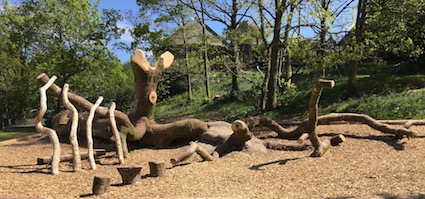
In May 2017 I was passing through Ambleside en route south and made my habitual stop at Rothay Park. To my amazement there had been a significant change. Sixteen months previously, the park suffered badly in the floods of Storm Desmond. Thus plans were put in place to move the old playground to a less flood prone area that had greater prominence within the park. and give it a complete makeover. The previous playpark had evolved in a more haphazard way with no particular thought given to the overall design, I believe.
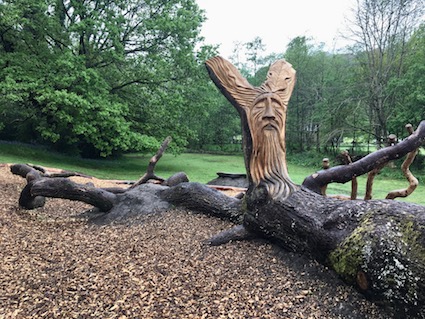
In my lifetime of 50 years, this is the third significant change to the play equipment in this park. This gives an indication of the nature of any investment into fixed play equipment in a public space. It needs to last a long time.

Around 1971-72, the playground from my childhood was installed. This was state-of-the art provision at the time. Not only were there swings, but a very tall slide, a witch’s hat, a fast roundabout, a mighty zig-zag and a cuboid climbing frame. All iconic Seventies equipment with asphalt being the underlying surface. Interestingly it was situated two sides of the large rock outcrop and I distinctly remember this adding to the play value in that this feature inherently became part of our play and a key choice of travel between the two parts of the playground.
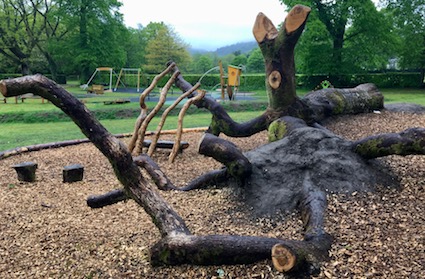
The brief clearly included the need for a mix of man-made and natural features and for a range of abilities and ages. What criteria were used for an inclusive playground I’m not exactly sure. I couldn’t find any indication of which company installed this playground and it would be helpful to know and find out more about the rationale behind the playground design from their perspective. However my understanding is that a number of community groups were consulted and reference was made in the brief for the need of the local school and nursery to be able to use the facilities.
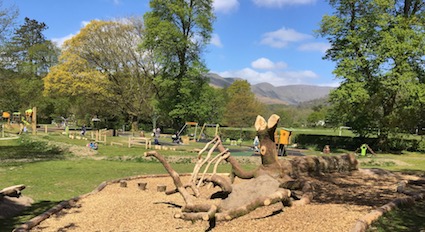
One of the nice elements of the park is the lack of fencing. Instead mounds are used to define the play area around the majority of the structures. I’m not sure why the decision was made to put the key natural play feature away from the main play area. During both times I visited, the families and children were congregating around the other parts. This seems a pity as clearly a lot of love and thought has gone into the design and installation of this play log area. The attention to detail is extraordinary. So for it not to have been fully integrated into the main play area appears from my external eye to be an oversight.
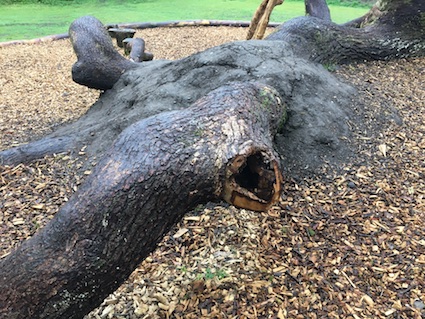
The photos above and below show the sort of detail which is unusual. Firstly the tree appears to be a local find. As an oak tree it will last a long time and blend into the park. The holes in the branches add interest. Below, a rough seat has been carved. However on closer inspection, I liked that it’s a hidden water play feature – the water runs off the edges onto the seat that’s gently inclined so that the water runs off and down a groove on the right hand side.

The seat also adds challenge to the main trunk by creating a thin ledge to balance along. I’m curious to know if the face is a particular tree spirit or local legend. Again – any advice or information here would be appreciated.
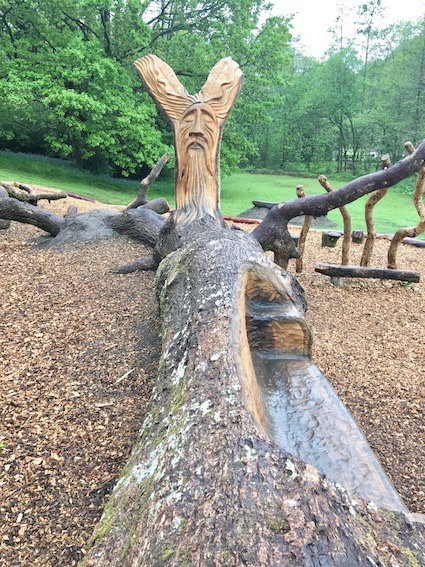
Finally I hope this play log does become a much-loved and integral part of the park. The natural element dovetails with the wider park which I’ve blogged about previously as a lovely unofficial play space. Certainly I’ll be checking it out whenever I visit to see how it’s changing and degrading over time. I’ve known many oak structures to last decades.
This blog post was originally published in May 2017.






























Hello,
You may be interested to know that this ‘play log’ was not ‘sourced locally’ in the way that you mean. Until earlier this year it was a lovely Oak Tree, much frequented by Nuthatches, Treecreepers and other birds, that stood (for over 100 years) where it now lies. The stump of its trunk is now covered by soil just to the left of where you see it. Without the move of the playground it would still be there but because more people now pass closely to where it stood it was felt that a defect within it might call it to fall down just as somebody was passing! It was then turned into this ‘play sculpture’. So yes, generations of children and adults may grow to love it even if they are completely oblivious to its story but its loss (as a tree) will always leave a hole in my heart. I believe that one of the best gifts we can give to children is to look at and really see the amazing beauty, ingenuity and value of the nature all around them. They will after be its custodians in the future.
Hello Lesley
Many thanks for finding this blog post and taking the time to comment. Your contribution adds insight which is really helpful. I did think the mounds of soil were unusual and your explanation makes sense as to why they are there. It also helps explain why the log is situated away from the rest of the new play space. As you say, the oak tree will be missed… and I saw that another tree in the large rock outcrop had also come down and a money tree being created there. However, I am pleased that the oak tree at least is laid to rest and play on-site and hopefully enable generations in years to come to appreciate trees. I think it is unlikely that I would be doing what I am doing if it wasn’t for Rothay Park and being able to spend hours playing there as a child.
Hello again,
Thank you for replying to my comment. Yes Rothay Park is a lovely park and the large rock next to the playground has been polished by generations of children, and adults scrambling over it. The other fallen tree quite literally fell off its rock, perhaps in high winds, it was there one day and gone the next. I feel there is a certain irony in that it fell across the entrance to the old playground, thank goodness nobody was there at the time. The council didn’t see that coming whereas the felled Oak, standing on level ground would in all likelihood have been there for many years yet. However what is done is done. I hadn’t spotted the ‘money tree’ developing, I will have to have a look. That has always struck me as a bit of a strange phenomenon. I think I heard people used to stick money into felled tree stumps to discourage further growth but that might be a myth. There is one on the way up the road to Stockghyll. Padlocks on bridges seem to be the latest craze round here, a lot were removed from the Bronwyn Nixon footbridge (built around 26 years ago) only to be replaced almost immediately by others! I hope yo still have many happy visits to our lovely park.
Hello Lesley – I think you are right about the development of money trees in the same vein as “love locks” on bridges. It’s been years since I went to Stockghyll but I do believe there’s an old coin stump there which has been around considerably longer up there.